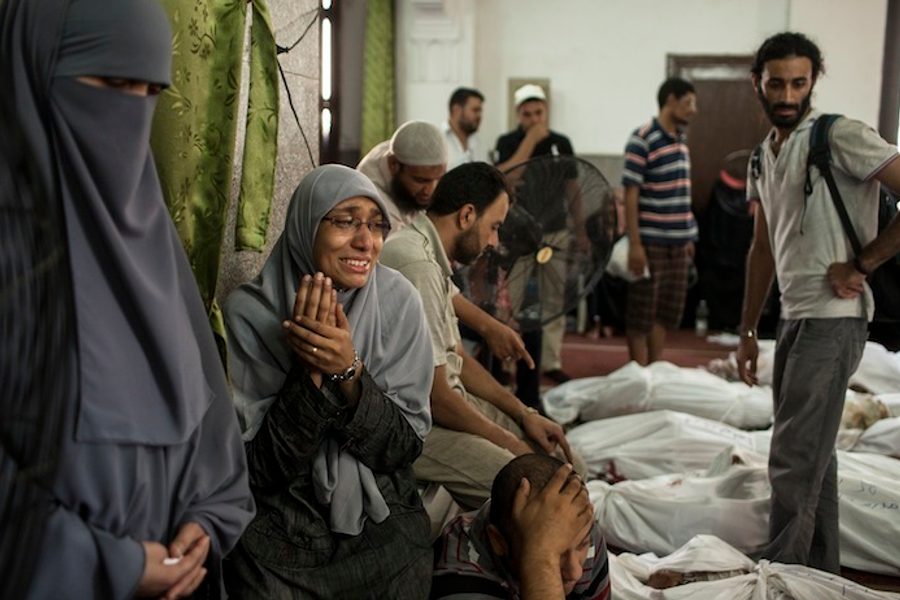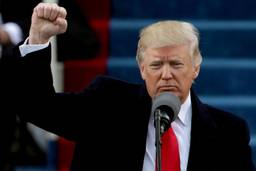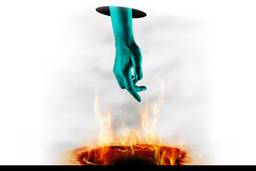
Now that the Egyptian Army has decided to break the stalemate and cleanse the public space of Islamist protesters, and the result is hundreds of deaths, one should first just imagine what an uproar this would have caused if the same bloodbath were to happen, say, in Iran. However, it is more urgent to take a step back and focus on the absent third party in the ongoing conflict: Where are the protesters who took over Tahrir Square two-and-a-half years ago? Is their role now not weirdly similar to the role of the Muslim Brotherhood during the 2011 Arab Spring — that of the impassive observer?
With the military coup in July—when the army, at first supported by those who ousted the Mubarak regime two years ago, deposed the democratically elected president and government — the circle has somehow closed: The protesters who toppled Mubarak in 2011, demanding democracy, passively supported a military coup d’état that subsequently abolished that democracy. What is going on?
The dominant reading that has been proposed by, among others, Francis Fukuyama, goes thusly: The protest movement that toppled Mubarak was predominantly the revolt of the educated middle class, with the poor workers and farmers reduced to the role of (sympathetic) observers. But once the gates of democracy were open, the theory continues, the Muslim Brotherhood, whose social base is composed of the poor majority, won democratic elections and formed a government dominated by Muslim fundamentalists. In turn, the original core of secular protesters turned against the new government, ready to endorse even a military coup as a way to stop them.
Such a simplified vision ignores a key feature of the protest movement: the explosion of heterogeneous organizations (of students, women, workers, etc.) through which Egyptian civil society has begun to articulate its interests outside the scope of state and religious institutions. This vast network of new social forms, much more than the overthrow of Mubarak, is the principal gain of the Arab Spring. It is an ongoing process, independent of big political changes like the Army’s coup against the Muslim Brotherhood government; it goes deeper than the religious/liberal divide.
The parallel we should draw here is between the Egyptian uprising and the failed 2009-2010 Green Revolution in Iran. The green color adopted by the supporters of the illegally defeated presidential candidate Hossein Moussavi and the cries of “Allahu Akbar!” that resonated from the roofs of Tehran in the evening darkness clearly indicated that they saw their activity as the undoing of the 1979 Khomeini revolution’s eventual corruption. This return to the revolution’s roots was not only programmatic; it also entailed the emphatic unity of the people and their all-encompassing solidarity. Through creative self-organization they improvised new ways to articulate protest with a unique mixture of spontaneity and discipline, like the ominous march of thousands in complete silence. We were dealing with a popular uprising of the deceived partisans of the Khomeini revolution: Moussavi’s name stood for the genuine resuscitation of the popular dream that sustained the revolution in the first place.
The 1979 Khomeini revolution cannot be reduced, therefore, to a hard line Islamist takeover. It was much more. The fact that the 2011 Green Revolution had to be stifled demonstrates that the Khomeini revolution was an authentic political event, a momentary opening that unleashed unheard-of forces of social transformation, a moment in which “everything seemed possible.” What followed was a gradual closing of possibility through the Islam establishment’s takeover of political control.
Reacting to the well-known characterization of Marxism as ”the Islam of 20th century,” Pierre-André Taguieff, secularizing Islam’s abstract fanaticism, observed that Islam is turning out to be ”the Marxism of 21st century,” prolonging, after the decline of Communism, its violent anti-capitalism. Do, however, recent vicissitudes of Muslim fundamentalism not confirm Walter Benjamin’s insight that “every rise of Fascism bears witness to a failed revolution”? The rise of Fascism is the Left’s failure: a proof that there was a revolutionary potential, a dissatisfaction, that the Left was unable to mobilize. And does the same not hold for today’s so-called “Islamo-Fascism”? Does the rise of radical Islam not correlate to the disappearance of the secular Left in Muslim countries? When Afghanistan is portrayed as the utmost Islamic fundamentalist country, who still remembers that, 40 years ago, it was a country with strong secular tradition, including a powerful Communist party that took power there independently of the Soviet Union?
Even in the case of clearly fundamentalist movements, one should be careful not to miss their social component. The Taliban, for example, are regularly presented in the mainstream media as fundamentalist Islamists who enforce their rule with terror. When, in the spring of 2009, they took over the Swat valley in Pakistan, the New York Times reported that they engineered “a class revolt that exploit[ed] profound fissures between a small group of wealthy landlords and their landless tenants.” If, however, by “taking advantage” of the farmers’ plight, the Taliban were “raising alarm about the risks to Pakistan, which remains largely feudal,” what prevents liberal democrats in Pakistan, as well as the United States, from similarly “taking advantage” of this plight and trying to help the landless farmers? But they have not, and the sad implication is that the feudal forces in Pakistan are the “natural ally” of the liberal democracy.
And this brings us back to Egypt: Far from being a neutral benevolent mediator and guarantor of social stability, the Army instead stands for and embodies a certain social and political program — roughly speaking, integration into global-market, pro-Western, authoritarian capitalism. As such, the Army’s intervention is needed insofar as the majority is not ready to accept capitalism “democratically.” In contrast to the Army’s secular vision, the Muslim Brotherhood endeavors to impose a fundamentalist-religious rule. Both of these ideological visions exclude what the Arab Spring protesters stood for: economic solidarity and justice; democracy of active, engaged citizens.
Although (almost) everyone enthusiastically supported the Tahrir Square democratic explosion, a hidden struggle to appropriate the meaning of the protests was quietly taking place. In the West, the official circles and most of the media celebrated Tahrir Square as similar to the “pro-democracy” velvet revolutions in Eastern Europe: a desire for Western liberal democracy, a desire to become like the West. But we shouldn’t be so fascinated by sublime moments of national unity. Rather, our focus should be on what happens the day after. How will this emancipatory explosion be translated into new social order? In the last decades, we witnessed a whole series of emancipatory popular explosions that were re-appropriated by the global capitalist order, either in its liberal form (from South Africa to Philippines) or in its fundamentalist form (Iran).
As we used to say almost half a century ago, one doesn’t have to be a weatherman to know which way the wind blows in Egypt: towards Iran. Even if the Army wins and stabilizes the situation, this very victory can breed a Fascist explosion, similar to the Khomeini revolution, that will sweep over Egypt in a couple of years. Only a worldwide coalition committed to the struggle for freedom and democracy and for social and economic justice can save us from this prospect.








